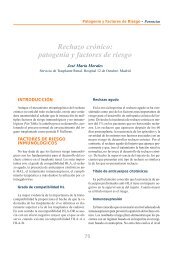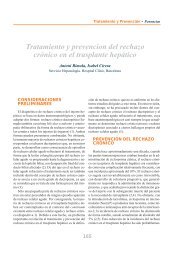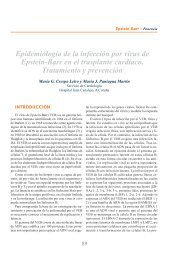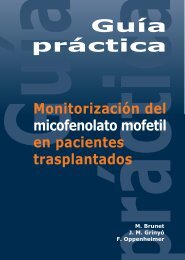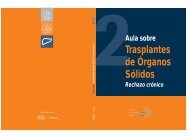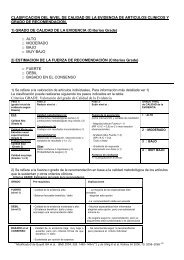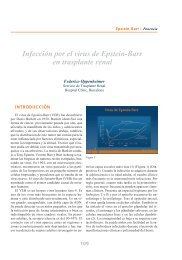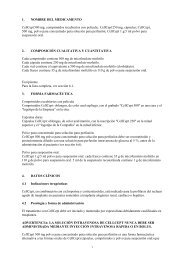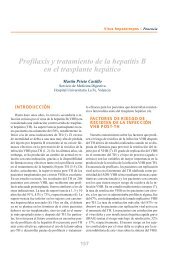Untitled - Roche Trasplantes
Untitled - Roche Trasplantes
Untitled - Roche Trasplantes
You also want an ePaper? Increase the reach of your titles
YUMPU automatically turns print PDFs into web optimized ePapers that Google loves.
BIOPSIA DE PROTOCOLO EN EL TRASPLANTE RENAL<br />
However, as shown from animal models or in sequential allograft indication biopsies C4d<br />
often can precede the onset of chronic humoral rejection, but the interval between the<br />
stages can be very variable and quite long, and it is not known whether progression is<br />
inexorable. Therefore, prospective long term follow-up is needed for cases of subclinical,<br />
C4d positive humoral rejection to clarify whether this is an unavoidable precursor of<br />
chronic humoral rejection or a sign of accommodation. Since current therapy for cases<br />
of acute humoral rejection can be related to various sever side effects more data are<br />
needed to further support already at an early time point (subclinical C4d detection without<br />
pathology = stage II) a specific therapeutic intervention for the prevention of chronic<br />
humoral rejection.<br />
ACCOMMODATION AND HUMORAL REJECTION<br />
Accommodation is defined as the resistance of an allograft to the acute pathological effects<br />
of allograft-specific antibodies and complement activation. This phenomenon was<br />
already observed in the late eighties in recipients of an ABO-incompatible renal allograft.<br />
Transient depletion of the circulating antibodies that are specific for the blood group antigens<br />
at the time of transplantation allows immediate allograft survival without hyperacute<br />
rejection. However, in 90% of the cases a rebound of the antibodies with high titers in<br />
patient’s serum leads to humoral rejection within the first 10 days. But the remaining<br />
showed no correlation between the occurrence of humoral rejection and antibody titers<br />
within the next 21 days. Even if the antibody titers return to pre-transplant levels or higher,<br />
the allografts continue to function. Findings from mice models showed that, in the absence<br />
of T-cell help (e.g., due to an initial conditioning regime), B-cells that are exposed<br />
to incompatible antigens on allografts differentiate into cells that can produce non-complement-fixing<br />
antibodies, and these B cells gradually become tolerant after a prolonged<br />
exposure.<br />
In HLA-mismatched allografts, alloantibodies can be found in the absence of clinical graft<br />
dysfunction, herewith fulfilling the criteria of accommodation. However, patients with circulating<br />
HLA-specific anti-donor antibodies have a greater likelihood of later allograft loss,<br />
indicating that, if accommodation occurs under transplant conditions, then it is either transient<br />
or insufficient to prevent chronic humoral rejection. Long term, complete accommodation<br />
has not been documented for MHC molecules in humans so far, and the phenomenon<br />
might therefore be partly determined by the nature of antigen.<br />
Several molecular pathways should be involved in accommodation. A central role is most<br />
probably located within the allografts’ endothelium which is thought to express cytoprotective<br />
proteins like anti-apoptotic BCL-2, BCL-X, and haem oxygenase 1 (HO-1).<br />
Increased expression of BCL-X was found in the endothelium of renal allografts from patients<br />
with circulating donor-specific antibodies. Furthermore, HLA-class-I-specific antibodies<br />
increase endothelial-cell expression of BCL-2, BCL-X, and HO-1, and increase the<br />
64




